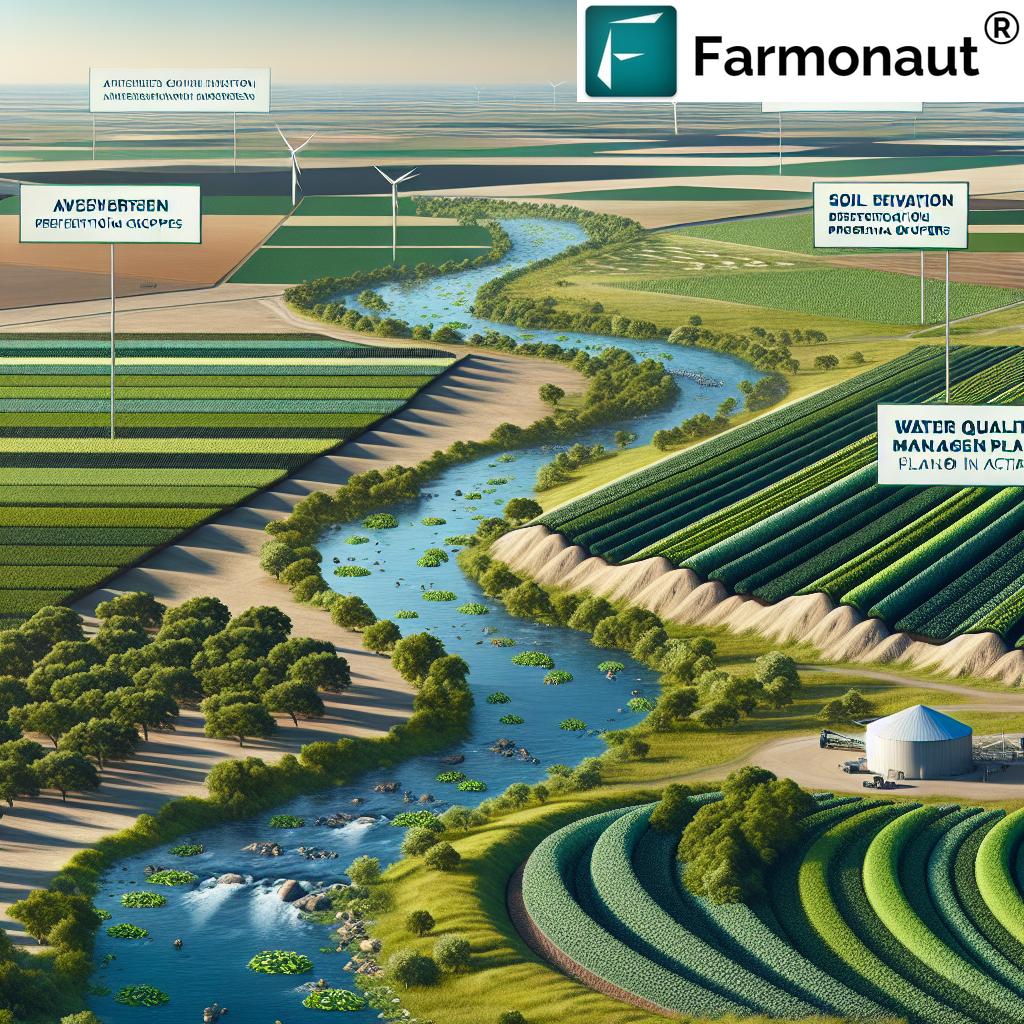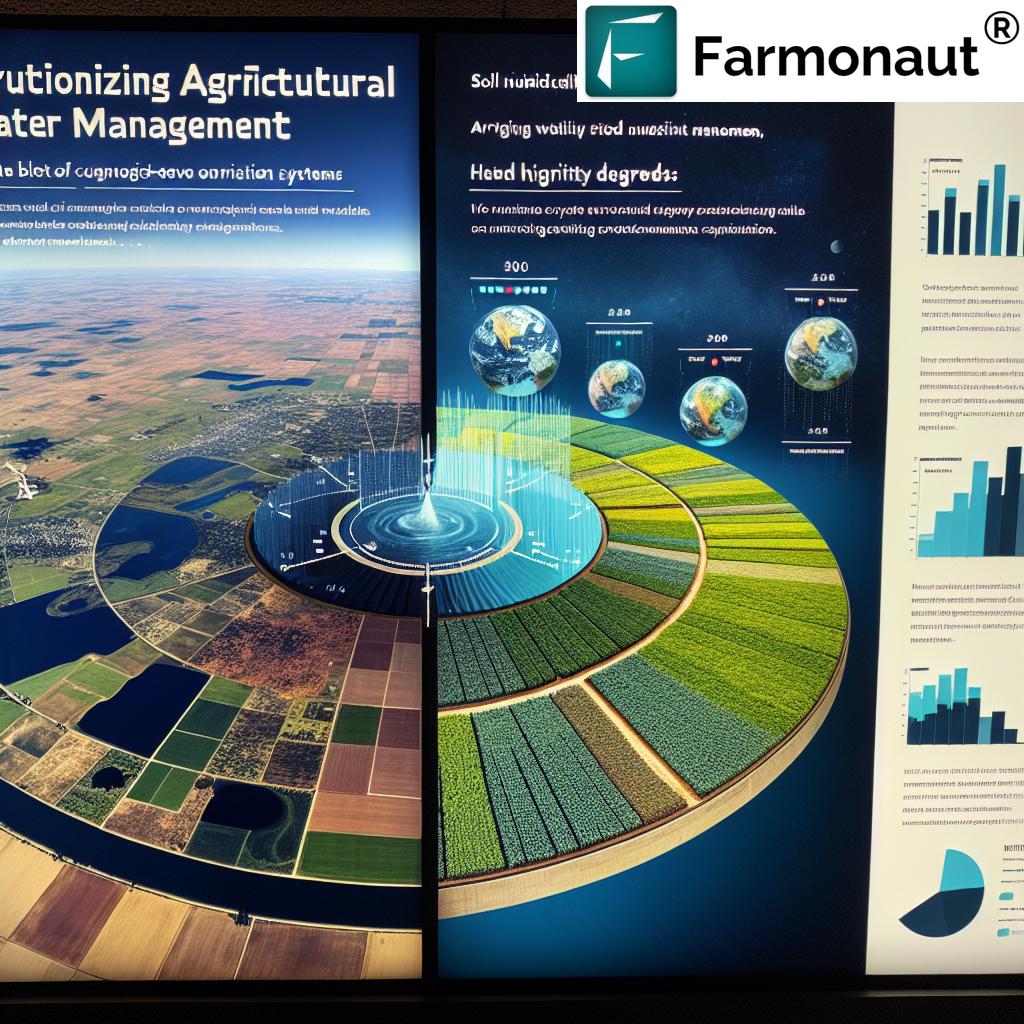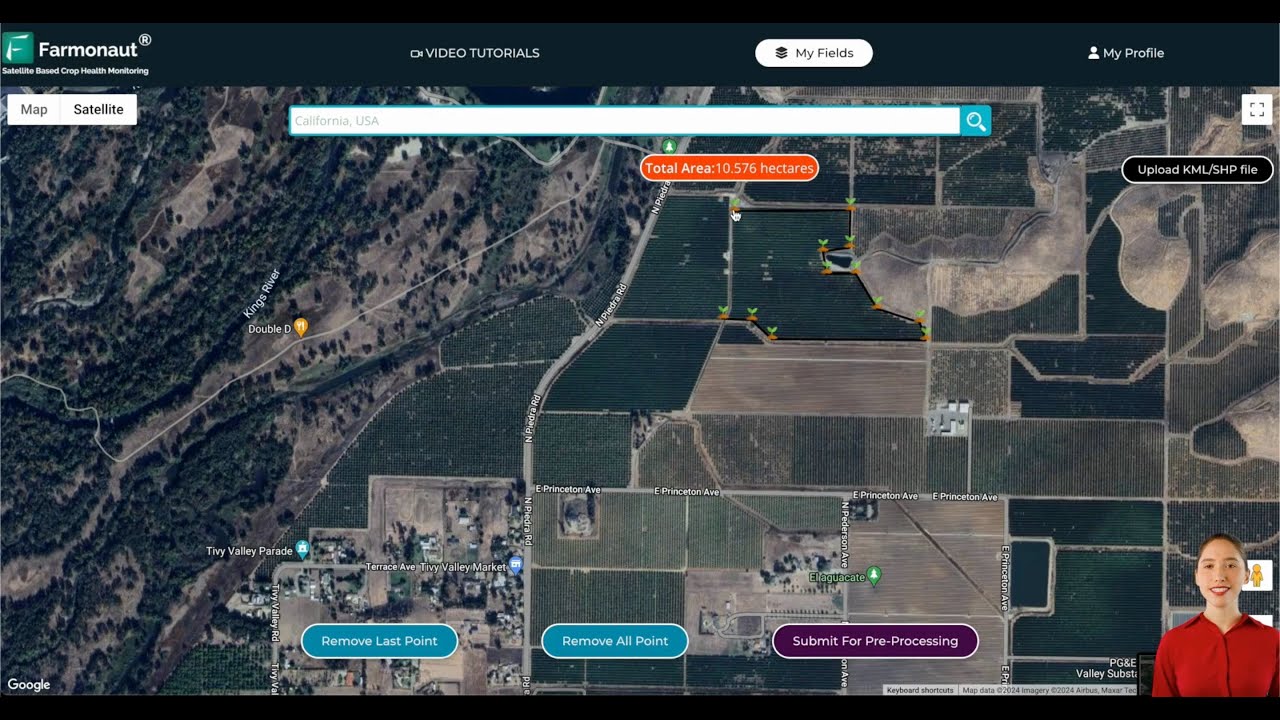Mastering Texas Water Quality Management: Sustainable Practices for Agricultural Conservation and Environmental Stewardship
“Texas’ Water Quality Management Plan program covers over 25 million acres of agricultural land, promoting sustainable farming practices.”
In the vast expanse of Texas, where agriculture plays a pivotal role in the state’s economy and identity, the importance of sustainable water management cannot be overstated. As we navigate the challenges of the 21st century, the Texas Water Quality Management Plan (WQMP) program stands as a beacon of hope, guiding farmers and ranchers towards practices that not only conserve our precious water resources but also protect the environment for future generations.
At Farmonaut, we recognize the critical role that innovative technology plays in supporting sustainable agriculture. Our satellite-based farm management solutions are designed to complement and enhance the efforts of programs like the WQMP, providing farmers with real-time insights and data-driven recommendations to optimize their water usage and improve overall farm management.

Understanding the Texas Water Quality Management Plan Program
The Water Quality Management Plan program is a cornerstone of Texas’ efforts to promote sustainable agriculture practices and soil and water conservation. Implemented by the Texas State Soil and Water Conservation Board (TSSWCB) in collaboration with local soil and water conservation districts, this program is designed to address nonpoint source pollution from agricultural and silvicultural activities.
Key aspects of the WQMP program include:
- Development of site-specific plans that address the unique needs of individual farms and ranches
- Implementation of best management practices (BMPs) tailored to local conditions
- Technical assistance provided by conservation experts
- Potential financial incentives for implementing approved plans
- Voluntary participation with the goal of achieving state water quality standards
By integrating these elements, the WQMP program offers a holistic approach to agricultural pollution control and efficient water resource management. This comprehensive strategy not only benefits the environment but also supports the long-term sustainability of Texas agriculture.
The Role of Soil and Water Conservation Districts
Local soil and water conservation districts play a crucial role in the implementation of the WQMP program. These districts serve as the primary point of contact for farmers and ranchers interested in developing a water quality management plan. Their responsibilities include:
- Conducting initial assessments of farm and ranch properties
- Collaborating with landowners to develop customized WQMPs
- Providing ongoing support and guidance throughout the implementation process
- Coordinating with state and federal agencies to ensure compliance with regulations
- Facilitating access to technical and financial assistance programs
The close partnership between local districts and landowners ensures that WQMPs are not only effective in addressing water quality concerns but also practical and feasible for implementation in real-world agricultural settings.
Best Management Practices: The Foundation of WQMPs
At the heart of every Water Quality Management Plan are the best management practices (BMPs) designed to mitigate agricultural pollution and promote sustainable farming. These practices are carefully selected based on their effectiveness in addressing specific environmental concerns while maintaining agricultural productivity.
Some common BMPs implemented under the WQMP program include:
- Nutrient management strategies to optimize fertilizer use and reduce runoff
- Erosion control measures such as contour farming and terracing
- Irrigation efficiency improvements to conserve water resources
- Integrated pest management to reduce reliance on chemical pesticides
- Riparian buffer zones to protect waterways from agricultural runoff
- Grazing management systems for improved rangeland health
By implementing these practices, Texas farmers and ranchers can significantly reduce their environmental impact while often improving their operational efficiency and productivity.
Explore how Farmonaut’s satellite-based crop health monitoring can support your BMP implementation. Try our web app today!


The WQMP Development Process
Developing a Water Quality Management Plan is a collaborative effort between landowners and conservation professionals. The process typically involves the following steps:
- Initial Consultation: Landowners meet with their local soil and water conservation district to discuss their goals and concerns.
- Site Assessment: Conservation experts conduct a thorough evaluation of the property, including soil types, topography, and current management practices.
- Plan Development: Based on the assessment, a customized WQMP is developed, incorporating appropriate BMPs and conservation strategies.
- Review and Approval: The plan is reviewed by the TSSWCB and, if necessary, other relevant agencies for approval.
- Implementation: Once approved, the landowner begins implementing the plan with support from the conservation district.
- Monitoring and Adjustment: The plan’s effectiveness is monitored over time, with adjustments made as needed to ensure continued success.
This process ensures that each WQMP is tailored to the specific needs of the individual farm or ranch, maximizing its potential for success in improving water quality and promoting sustainable agriculture practices.
“Implementing a WQMP can reduce agricultural water usage by up to 30%, significantly contributing to water conservation efforts in Texas.”
Technical Assistance and Funding Opportunities
One of the key strengths of the WQMP program is the comprehensive support provided to participating landowners. This support includes:
- Technical Assistance: Conservation experts provide guidance on BMP selection, implementation, and maintenance.
- Educational Resources: Workshops, field days, and informational materials help landowners stay informed about the latest conservation techniques.
- Financial Incentives: Various state and federal programs offer cost-share assistance for implementing approved WQMPs.
- Ongoing Support: Local conservation districts provide continued assistance throughout the life of the plan.
These resources ensure that landowners have the knowledge and means to successfully implement their WQMPs, overcoming potential barriers to adoption.
Farmonaut’s Jeevn AI Advisory System can complement the technical assistance provided by conservation experts. Learn more about our AI-driven insights.

Addressing Diverse Agricultural Needs
The Texas WQMP program recognizes the diverse nature of agriculture across the state. From vast crop lands to extensive rangelands, each agricultural operation faces unique challenges and opportunities for conservation. The program’s flexibility allows for the development of plans that address:
- Crop-specific management strategies
- Livestock and poultry operations
- Rangeland and pasture management
- Forestry and silviculture practices
- Specialty crop production
This comprehensive approach ensures that all sectors of Texas agriculture can participate in and benefit from the WQMP program, contributing to the overall goal of improved water quality across the state.
Integration with Broader Conservation Efforts
The Water Quality Management Plan program does not operate in isolation. It is an integral part of Texas’ broader efforts to promote environmental stewardship and sustainable resource management. The program aligns with and supports other initiatives, including:
- The Texas Nonpoint Source Management Program
- Watershed Protection Plans
- The Environmental Quality Incentives Program (EQIP)
- The Conservation Stewardship Program (CSP)
- Various state and regional water conservation initiatives
By coordinating with these programs, the WQMP initiative maximizes its impact and ensures a cohesive approach to addressing water quality and conservation challenges across Texas.
Farmonaut’s satellite-based solutions can provide valuable data for watershed management and conservation planning. Explore our API for integration possibilities.
The Role of Technology in Modern Water Quality Management
As we strive to enhance the effectiveness of Water Quality Management Plans, the integration of cutting-edge technology becomes increasingly crucial. At Farmonaut, we’re at the forefront of this technological revolution in agriculture, offering solutions that complement and enhance the WQMP program’s objectives.
- Satellite-Based Crop Health Monitoring: Our advanced imagery analysis provides real-time insights into vegetation health, helping farmers optimize irrigation and fertilizer use.
- AI-Driven Advisory Systems: The Jeevn AI system offers personalized recommendations based on satellite data, weather forecasts, and local conditions, supporting informed decision-making in line with WQMP goals.
- Precision Resource Management: Our tools enable precise application of water and nutrients, reducing waste and minimizing environmental impact.
- Carbon Footprint Tracking: By monitoring emissions and resource use, we help farms align with sustainability goals and potentially access carbon credit markets.
These technological solutions not only support the implementation of WQMPs but also provide valuable data for ongoing monitoring and improvement of conservation practices.
Ready to bring cutting-edge technology to your farm management strategy? Try Farmonaut’s web app now!

Challenges and Future Directions
While the Texas WQMP program has made significant strides in promoting sustainable agriculture and water quality management, challenges remain. Some of the key issues and future directions include:
- Adapting to climate change and increasing water scarcity
- Expanding program participation, especially among smaller farms
- Enhancing data collection and analysis for more targeted interventions
- Integrating emerging technologies for more efficient resource management
- Addressing new and emerging pollutants in agricultural runoff
As we look to the future, the continued evolution of the WQMP program, coupled with technological advancements, will be crucial in meeting these challenges and ensuring the long-term sustainability of Texas agriculture.
Texas WQMP Best Management Practices Comparison
| BMP Category | Specific Practice | Water Quality Impact | Soil Conservation Benefit | Implementation Cost | Potential Funding Sources | Farmonaut Technology Integration |
|---|---|---|---|---|---|---|
| Nutrient Management | Precision Fertilizer Application | 25% improvement | 4/5 | $5,000 – $15,000 | EQIP, CSP | Satellite imagery for targeted application |
| Irrigation Efficiency | Drip Irrigation Systems | 30% improvement | 3/5 | $1,000 – $3,000 per acre | WQMP Cost-Share, EQIP | AI-driven irrigation scheduling |
| Soil Conservation | Cover Cropping | 20% improvement | 5/5 | $30 – $50 per acre | CSP, WQMP Cost-Share | Vegetation health monitoring |
| Erosion Control | Contour Farming | 15% improvement | 4/5 | $20 – $40 per acre | EQIP, Local Conservation Districts | Topography analysis for optimal contouring |
| Pest Management | Integrated Pest Management (IPM) | 10% improvement | 3/5 | $10 – $20 per acre | CSP, WQMP Cost-Share | Early pest detection through satellite imagery |
This table provides a comprehensive overview of some key best management practices implemented under the Texas Water Quality Management Plan program. It illustrates the multifaceted approach to water quality management in Texas agriculture, highlighting the potential benefits, costs, and technological support available for each practice.
Discover how Farmonaut’s technology can enhance your implementation of these BMPs. Check out our API Developer Docs for integration options.
Environmental Data Quality Management
A critical aspect of the WQMP program’s success is the accurate collection, analysis, and management of environmental data. This data forms the foundation for decision-making, policy development, and the evaluation of conservation efforts. Key components of environmental data quality management include:
- Standardized data collection protocols
- Quality assurance and quality control procedures
- Data storage and management systems
- Analysis and reporting tools
- Data sharing and accessibility initiatives
By ensuring the integrity and reliability of environmental data, the WQMP program can more effectively target its efforts and demonstrate its impact on water quality improvement across Texas.
Conclusion: A Sustainable Future for Texas Agriculture
The Texas Water Quality Management Plan program stands as a testament to the state’s commitment to sustainable agriculture and environmental stewardship. By providing a framework for the implementation of best management practices, offering technical and financial assistance, and fostering collaboration between landowners and conservation experts, the program is making significant strides in protecting Texas’ water resources while supporting the agricultural community.
As we look to the future, the integration of innovative technologies, like those offered by Farmonaut, will play an increasingly important role in enhancing the effectiveness of WQMPs. Our satellite-based monitoring, AI-driven advisory systems, and data analytics tools complement the program’s objectives, providing farmers with the insights they need to make informed decisions about resource management and conservation practices.
Together, through the combined efforts of dedicated landowners, conservation professionals, and cutting-edge technology providers, we can ensure a sustainable and prosperous future for Texas agriculture, preserving our precious water resources for generations to come.
Frequently Asked Questions (FAQ)
- What is a Water Quality Management Plan (WQMP)?
A WQMP is a site-specific plan developed for agricultural or silvicultural lands to help prevent and manage nonpoint source pollution, improving overall water quality. - Who is eligible to participate in the Texas WQMP program?
Any agricultural or silvicultural operation in Texas, regardless of size, can participate in the WQMP program. - How long does it take to develop and implement a WQMP?
The timeline can vary depending on the complexity of the operation, but typically ranges from several weeks to a few months for development, with implementation occurring over several years. - Are there financial incentives available for implementing a WQMP?
Yes, various state and federal programs offer cost-share assistance for implementing approved WQMPs. Contact your local soil and water conservation district for specific information. - How does Farmonaut’s technology support WQMP implementation?
Farmonaut’s satellite-based monitoring and AI advisory systems provide real-time data and insights that can help farmers more effectively implement and manage their WQMPs, optimizing resource use and conservation efforts.
Ready to enhance your farm’s sustainability with cutting-edge technology? Explore Farmonaut’s solutions today!

















